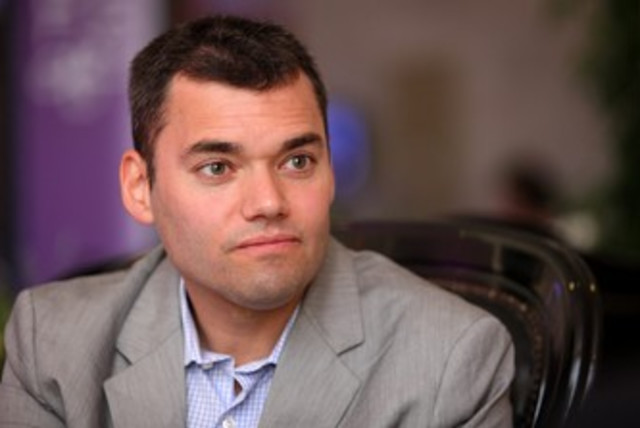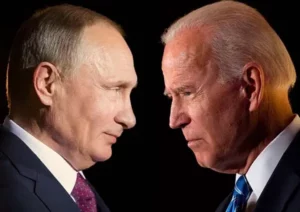Stripping Away the Bulls**t: U.S. and Russian Threats over Ukraine—What They’re about and Who’s the Aggressor
SPOTLIGHT, 7 Feb 2022
Dee Knight | CovertAction Magazine - TRANSCEND Media Service
25 Jan 2022 – Threats and counter-threats flying between Washington and Moscow over Ukraine have caused a flurry of fear and confusion that escalates and expands daily. Is the world on the brink of war? What is it about, who is the aggressor and who is to blame?
The dangerous standoff has lasted for most of a year. Each side accuses the other of threatening war—in a way reminiscent of the Cuban missile crisis of 1962.
During a week of intense diplomatic meetings in three European capitals, which appeared to reach a dead end, President Joe Biden seemed to “blink” midweek, on January 19, telling reporters in Washington he had indicated to Russian President Putin that “we can work out something.”
New York Times senior reporter David Sanger jumped on it: “Mr. President, it sounds like you’re offering some way out here, some off-ramp—an informal assurance that NATO is not going to take in Ukraine… and we would never put nuclear weapons there.” Sanger went on to say Russia “wants us to move all of our nuclear weapons out of Europe and not have troops rotating through the old Soviet bloc.” Biden quickly said “No, there’s not space for that.”

Biden’s blink was a break in the warlike atmosphere that has prevailed endlessly. Katrina van den Heuvel wrote the day before in The Washington Post that “Hotheads [were] having a field day. A White House task force that includes the CIA [was] reportedly contemplating U.S. support for a guerrilla war if Russia seizes Ukraine; Russian hawks talk of a military deployment to Cuba and Venezuela.” Biden had “installed a team of national security managers from the ‘Blob,’ marinated in successive debacles in Iraq, Libya, Syria, Yemen and more.”
Guns and sanctions are the U.S. empire’s preferred options, van den Heuvel said: “with about 800 military bases outside the United States,” the U.S. has “more bases than diplomatic missions. (Russia’s only military bases outside the former Soviet Union are in Syria.)” She added that Secretary of State Blinken and the Blob “talk about a rules-based international order but respect it only if we make the rules, often exempting ourselves from their application.”

Spheres of influence?
“When will the U.S. stop lying to itself about global politics?” asked CUNY Professor Peter Beinart, writing in the New York Times on January 13. He took issue with Secretary of State Antony Blinken, who pontificated last month that “One country does not have the right to dictate the policies of another or to tell that country with whom it may associate; one country does not have the right to exert a sphere of influence. That notion should be relegated to the dustbin of history.”
Beinart commented: “It’s a noble principle, just not one the United States abides by. The United States has exercised a sphere of influence in its own hemisphere for almost 200 years, since President James Monroe declared that the United States ‘should consider any attempt’ by foreign powers ‘to extend their system to any portion of this hemisphere as dangerous to our peace and safety’.”

Blinken’s dustbin of history was still around in 2018, Beinart said, when Trump’s Secretary of State Rex Tillerson called the Monroe Doctrine “as relevant today as it was the day it was written.” And Trump’s National Security Adviser John Bolton boasted that “the Monroe Doctrine is alive and well.”
Blinken wants a one-way street where spheres of influence are concerned. The U.S., for him, has the right to wield influence everywhere, while others don’t.

The same day Biden blinked, French President Macron weighed in saying war would be the “most tragic thing of all.” Speaking in the European Union’s capital of Strasbourg, as new interim EU chair, Macron said he hoped to revitalize the four-way “Normandy format” talks between Russia, Germany, France and Ukraine to find a solution to the Ukraine crisis. “It is vital that Europe has its own dialogue with Russia,” Macron said. The EU had no part in the talks last week between Russia, the U.S., NATO and the Organization for Security and Cooperation in Europe (OSCD).

The Normandy format has been a vehicle for implementing the 2015 Minsk agreements designed to end the separatist war in Ukraine’s Donbas region. This solution has already been proposed and accepted in principle, according to Anatol Lieven, who wrote in The Nation that the Minsk II agreement was already adopted by France, Germany, Russia and Ukraine in 2015, and endorsed unanimously by the UN Security Council.
Key elements of the Minsk II deal are full autonomy for Ukraine’s eastern regions in the context of decentralization of power in Ukraine, demilitarization, and restoration of Ukrainian sovereignty. Despite agreement by all parties, political analyst Anatol Lieven says “because of the refusal of Ukrainian governments to implement the solution and refusal of the United States to put pressure on them to do so,” the settlement is a kind of “zombie policy.”
The issue of NATO expansion is another “zombie policy” as the U.S. refuses to acknowledge Russia’s legitimate opposition to it.
After the first of three negotiating sessions between the U.S. and Russia during the week of January 10, Russian Deputy Foreign Minister Sergei Ryabkov had declared it “absolutely mandatory” that Ukraine “never, never, ever” become a NATO member. In response, U.S. Deputy Secretary of State Wendy Sherman said: “we will not allow anyone to slam closed NATO’s open-door policy.”

When U.S. Defense Secretary Lloyd Austin met with Ukraine’s President Zelensky in Kyiv in October, he promised U.S. support for Ukraine’s future NATO membership, and blamed Russia for “perpetuating the war in eastern Ukraine.” Russian President Putin shot back on December 23 that “Further movement of NATO eastward is unacceptable. They are on the threshold of our house.”

Last March 24, the Ukrainian president decreed that Ukraine would take Crimea back from Russia, with “military measures” to achieve “de-occupation.” The U.S. and NATO voiced “unwavering” support.
In April NATO backed a Ukrainian offensive in its civil war against Russian-allied separatists in the eastern provinces, Donetsk and Luhansk. That is when Russia moved more troops to its borders with Ukraine, signaling it would defend its allies (Former CIA Case Officer and CAM columnist John Kiriakou has reported that the actual number of Russian troops massed on the Ukraine border, estimated between 70,000 and 90,000, was the same number that had been there for the last eight years, and that Western media reports of a Russian troop buildup were inflammatory. Vice-Admiral Kay-Achim Schönbach, the head of the German navy, was forced to resign after saying talk of a Russian invasion of Ukraine was “nonsense” and that Russia was merely seeking “respect” for its security concerns in Europe).

Last summer 30,000 U.S. troops led “Operation Defender Europe 2021,” a set of NATO exercises from the Baltic Sea to the Black Sea, according to the U.S. Peace Council. In December the U.S. staged simulated bombing raids within 12 miles of Russian airspace. NATO warplanes confronted Russian aircraft 290 times in 2021.

The CIA since 2015 had secretly trained elite Ukrainian Special Forces units in firearms, camouflage techniques, land navigation, tactics like “cover and move,” intelligence and other areas.
On December 7, Undersecretary of State Victoria Nuland told the Senate Foreign Relations Committee the U.S. has given $2.4 billion to Ukraine since 2014 “in security assistance”—$450 million in 2021 alone. (This week, the Biden administration approved an additional $200 million in military aid to add to the $450 million given last year).

Nuland helped orchestrate the 2014 coup in Kyiv, the Ukrainian capital, that toppled a government friendly to Russia. The new far-rightist government ended language rights for Russian speakers who are the majority in the Ukraine’s eastern provinces. Donetsk and Lugansk voted to separate, as did Crimea. Russia then annexed Crimea, to protect Russian speakers there and secure its Black Sea naval base. Russia provided humanitarian aid and trade to Donetsk and Lugansk, and stationed troops on their eastern border for protection.

“Pro-Democracy Protests” or a Fascist Coup?
A New York Times report on January 6 said “Russia intervened militarily in Ukraine in 2014 after pro-democracy protests erupted there.” [Emphasis added.] The coup was actually carried out by fascist gangs, according to a May 2, 2018, report in The Nation by Stephen Cohen.
The gangs, including self-declared neo-Nazis, were encouraged by Nuland, Biden and other prominent U.S. politicians. The neo-Nazis were integrated into Ukraine’s official military which, since 2014, has been trained, armed and reorganized by the U.S., Britain, Canada and other NATO countries.
Stephen Cohen wrote that “the pogrom-like burning to death of ethnic Russians and others in Odessa later in 2014 reawakened memories of Nazi extermination squads in Ukraine during World War II.” These horrors have been all but deleted from the American mainstream narrative, despite being well-documented.
Cohen added that “stormtroop-like assaults on gays, Jews, elderly ethnic Russians, and other ‘impure’ citizens are widespread throughout Kyiv-ruled Ukraine, along with torchlight marches reminiscent of those that eventually inflamed Germany in the late 1920s and 1930s… The police and official legal authorities do virtually nothing to prevent these neo-fascist acts or to prosecute them. On the contrary, Kyiv has officially encouraged them by systematically rehabilitating and even memorializing Ukrainian collaborators with Nazi German extermination pogroms and their leaders during World War II, renaming streets in their honor, building monuments to them, rewriting history to glorify them, and more.”

The people of the self-declared people’s republics of Donetsk and Lugansk in eastern Ukraine suffer under a complete economic blockade by Ukraine and its Western allies. Historically known as the Donbass region, eastern Ukraine is a mining and industrial center. Donbass miners played a crucial and heroic role in the defeat of the German invasion of the Soviet Union in World War II. Many Russians revere the Donbass as “the heart of Russia.”
All of Ukraine east of the Dnieper river is predominantly Russian-speaking. U.S. claims of a “Russian invasion” are reminiscent of claims of North Vietnamese invasion of South Vietnam after the artificial separation of Vietnam in 1954. The entire U.S. narrative about Ukraine is a cynical fabrication designed to justify aggression.
Russian Security Proposals
In mid-December Russia took a diplomatic initiative and presented a list of security proposals to the United States. According to the Wall Street Journal, they include ending NATO’s expansion further eastward to include Ukraine, a promise for each side to refrain from hostile activities, and an end to NATO military activities in all of Eastern Europe, Transcaucasia and Central Asia.
“There is no other option,” Russian Deputy Foreign Minister Ryabkov told reporters, “since a characteristic feature of the current stage of relations between Russia and the collective West is a complete lack of trust.” The Russian diplomat also said “we have no intention to invade Ukraine.”

Among the “severe consequences” threatened by the U.S. against Russia, the Financial Times has said sanctioning Russia’s Nord Stream 2 gas pipeline to Germany was “top of the list.” Western Europe is already facing an energy crunch, with skyrocketing prices for natural gas.

Europeans need energy security and are wary of war. They want the Nord Stream 2 pipeline as soon as possible, while the Biden administration calls it a “bad deal” and claims that it makes Europe vulnerable to Russian “treachery.” Texas Senator Ted Cruz has pressed hard against the pipeline, which offsets opportunities for U.S. energy companies to supply gas to the European market. U.S. foreign adventures have often constricted Europe’s energy sources.

A 2021 survey by the European Council on Foreign Affairs found that most Europeans want to remain neutral in any U.S. war against Russia or China. But new NATO member-states align with the U.S. against Russia. They have installed terminals to receive U.S. liquid natural gas deliveries, to reduce dependence on Russian gas.
Despite all the diplomatic efforts, powerful institutional and economic forces in the U.S.—the military industrial complex and big energy companies among others—are eager for a new Cold War with Russia, which would provide them with boundless opportunities for profitable deals. “The U.S. military-industrial complex needs enemies like human lungs need oxygen,” the saying goes. “When there are no enemies, they must be invented.”
The demonization of Vladimir Putin and Russia by the U.S. media is part of this policy of inventing enemies. There is a long list of foreign leaders and nations whose attempts to defy the dictates of Washington and pursue an independent foreign policy have brought down upon them the wrath of the U.S. Capitalist Empire.
________________________________________________
 Dee Knight is a member of the DSA International Committee’s Anti-War Subcommittee. He is the author of My Whirlwind Lives: Navigating Decades of Storms, soon to be published by Guernica World Editions. Dee can be reached at: deeknight816@gmail.com.
Dee Knight is a member of the DSA International Committee’s Anti-War Subcommittee. He is the author of My Whirlwind Lives: Navigating Decades of Storms, soon to be published by Guernica World Editions. Dee can be reached at: deeknight816@gmail.com.
Go to Original – covertactionmagazine.com
Tags: Biden, Eastern Europe, Putin, Russia, USA, Ukraine
DISCLAIMER: The statements, views and opinions expressed in pieces republished here are solely those of the authors and do not necessarily represent those of TMS. In accordance with title 17 U.S.C. section 107, this material is distributed without profit to those who have expressed a prior interest in receiving the included information for research and educational purposes. TMS has no affiliation whatsoever with the originator of this article nor is TMS endorsed or sponsored by the originator. “GO TO ORIGINAL” links are provided as a convenience to our readers and allow for verification of authenticity. However, as originating pages are often updated by their originating host sites, the versions posted may not match the versions our readers view when clicking the “GO TO ORIGINAL” links. This site contains copyrighted material the use of which has not always been specifically authorized by the copyright owner. We are making such material available in our efforts to advance understanding of environmental, political, human rights, economic, democracy, scientific, and social justice issues, etc. We believe this constitutes a ‘fair use’ of any such copyrighted material as provided for in section 107 of the US Copyright Law. In accordance with Title 17 U.S.C. Section 107, the material on this site is distributed without profit to those who have expressed a prior interest in receiving the included information for research and educational purposes. For more information go to: http://www.law.cornell.edu/uscode/17/107.shtml. If you wish to use copyrighted material from this site for purposes of your own that go beyond ‘fair use’, you must obtain permission from the copyright owner.

Who the aggressor is doesn’t matter to the War Corporations. Wars are lethal games that like all games, must have someone who kicks the ball first. In his excellent article, Dee Knight says “Threats and counter-threats flying between Washington and Moscow over Ukraine”, but this is only for the Media, so that the masses can follow the drama. The reality is different. Threats do not exist. It is all negotiated in the most civilized way, by American and Russian diplomats, both in permanent consultations with the Ukrainian counterparts. This is why Governments spend so much money in diplomatic missions; to negotiate many things for them – wars included -. All three countries have \embassies in each other’s country, complete with military and trade attachés, who are in daily negotiations with the host country. Additionally, they meet daily at the United Nations buildings in New York and Geneva.
We should not forget the Ukraine is one of the founding members of the United Nations, that is, very experienced at war diplomacy, war negotiations and Arms Trade. Additionally, Relations between the European Union (EU) and Ukraine are paramount, shaped through the Ukraine–European Union Association Agreement and the Deep and Comprehensive Free Trade Area (DCFTA). Don’t forget Ukraine is a priority partner within the Eastern Partnership and the European Neighbourhood Policy (ENP).
Dee Knight says Europeans are wary of war, but this is neither here nor there, because MIC is not wary of making money to pay the millions of workers who make wars possible. Without the huge labour force that works day and night to produce the killing toys and the labour force prepared to kill and die, wars could never take place.
Only the Universal Abolition of Militarism will bring about a warless world.
This commentary appeared first in Covert Action Magazine on January 25, 2022